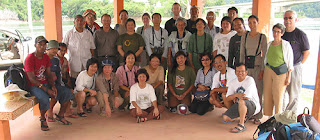
I had heard of the Save Belum-Temengor Postcard Campaign but had no idea where Belum-Temengor was. An invitation to join the MNS Bird Group trip to Belum was a great incentive to find out more. The sum of my knowledge was that MNS had successfully motivated the Malaysian public to lobby the government on an issue of environmental conservation. The cessation of logging in Temengor and the gazettement of Royal Belum as a State Park are remarkable achievements and a source of optimism for protection of other threatened ecosystems. I couldn’t wait for the opportunity to explore a tiny part of this 117,500ha Park.

My initial observation was disappointment at the disturbed forest and low quality development at Banding Island. This faded as we took to the water and an MNS flotilla buzzed toward the upper reaches of Temengor Lake. Here I was quickly lulled into the beauty of the landscape characterised by an intact jungle canopy with many tall emergent trees. I couldn’t quite shake the feeling however of floating above a submerged forest. Bleached white tree trunks at the lake margin are eerily photogenic and a nagging reminder of the many more skeletal branches reaching for the underside of our fragile craft.

As the lake narrowed I kept a keen eye out for Belum’s most famous resident, the Malayan Tiger. Apparently not constrained by water, it would be my ideal scenario to meet a wild tiger while it was swimming and I was on a boat with the engine running. For birdwatchers Belum-Temengor has the cachet of being the only place where you can see all ten of Malaysia’s Hornbills, of which the writer recorded a paltry five. I like to think of it as leaving some for next time.

Of those ten species it is the Plain-pouched Hornbill which is most appealing as it cannot be seen anywhere else in Malaysia. This vulnerable Hornbill was until recently considered conspecific with the Wreathed Hornbill. Although visually almost identical, it differs significantly in its habit of gathering in large flocks occasionally over 1000 strong. To add to the mystique, nobody knows where these birds roost and no one has ever found a nesting site. As the Hornbill’s habitat is being lost to deforestation there is urgent need to answer these questions if we are to come up with an effective conservation strategy.
Conserving Belum is a great first step to securing a contiguous area of old-growth forest that might just be large enough to sustain populations of large charismatic mammals and birds. As a conservation model however it is compromised by the fact that it necessitated the destruction (through flooding) of over 15,000ha of forest.
The conundrum is that in the current political climate it is difficult to argue for conservation for its own sake. It also helps to have an economic incentive. In this case conservation of forests in the catchment area will slow down the rate at which Temengor Reservoir will silt up. Another powerful incentive is that the creation of a large man-made lake provides far more recreational opportunities which appeal to a broader spectrum of people than a simple rainforest reserve could on its own.
As a purist birdwatcher I might claim that being stuck on a boat can not compare to sweating it out on steep muddy trails and being torn by rotan. But on the other hand, there is something civilised about watching ospreys whilst sitting amongst friends with your binoculars in one hand and a parasol in the other.
If the convenience of boat travel helps to encourage more people to visit the rainforest, be they bird-watchers, fishermen or day trippers, then on balance it could be a good thing. From a conservation point of view, visitors create more than just an economic incentive. People, especially locals, who come to value nature for recreation and as part of their heritage, are more likely to sign a postcard saying ‘Save Belum-Temengor’.
In all it was a most memorable trip and gives me hope for more Nature Conservation in Malaysia. And while I am being optimistic – I will see a Plain-pouched Hornbill next time.

Written by Ian Hall
Photographs by John Steed







No comments:
Post a Comment